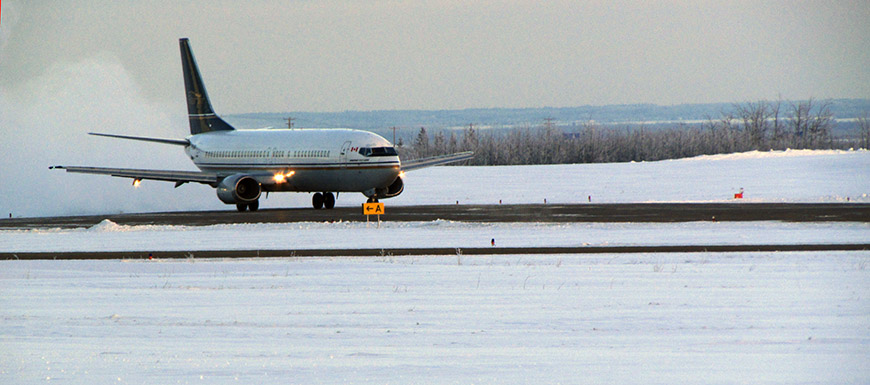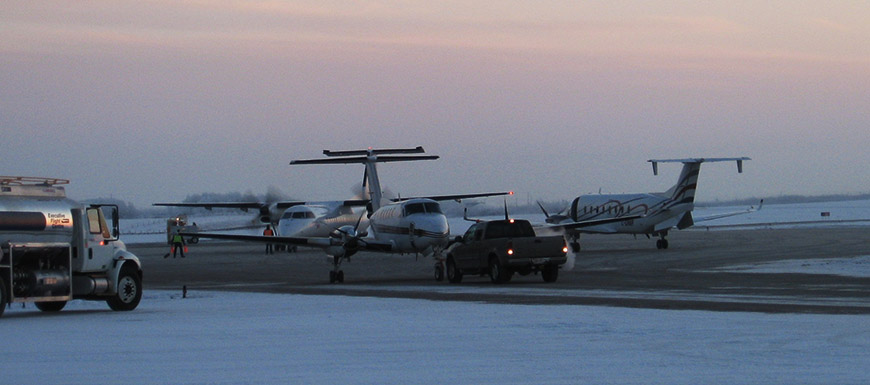(Pictured above: An air ambulance sits on the tarmac at Peace River Regional Airport)
What’s going on?
- Alberta Health Services (AHS) is in the process of concluding a Request For Proposals (RFP) process regarding air ambulance services, while the Town of Peace River both utilizes and respects the RFP process, we feel this one has some notable irregularities. Below is a letter published in the Wednesday, May 17, 2017, print edition of the Peace River Record-Gazette that outlines the position.
- From Mayor Tom Tarpey,
Maybe you’ve read recently that the Peace River Regional Airport is facing a situation that could cause its closure. While I don’t wish to be an alarmist, I must also be frank: we are in a situation that could result in the loss of our airport.
In a nutshell, Alberta Health Services (AHS) is looking to award a contract for air ambulance services in Peace River. They have an agreement in principle with a company to provide those services. However, that company does not currently have land at the Peace River Regional Airport, nor is there land available to lease or sell. That means they do not have a hanger located there.
Despite this, AHS has decided to push ahead anyway and the next step is to take the agreement in principle to the AHS board later this month for approval.
Our concern is that if they proceed with their preferred candidate, we will lose scheduled air service at the airport. While AHS has said that’s “not our problem” (yes, they said that!), it should be.
The Town of Peace River receives about $2 million a year in federal funding from the Airport Capital Assistance Program (ACAP). This funding is critical to the maintenance of the runway, taxiway, and buildings. Without this funding, the taxes for the residents of Peace River would go up by 20 percent. You read that correctly: a 20% tax increase to make up the shortfall and subsidize the Air Ambulance. That’s something we can’t ask of our ratepayers and the only option at that point would be to take the airport off our books by closing it.
This isn’t a flippant comment either, this is serious stuff. 50 direct jobs are at stake here. A fortunate few have an option to find jobs elsewhere, but most do not. The Minister of Health herself called the airport an “economic portal.” That runway and terminal building connect us to the rest of the province and the country in a very significant way.
AHS is being flippant when they say that airport viability is not their concern. Of course, it is their concern! If the airport closes, how will they operate an air ambulance base out of it?
We understand that they are under pressure to find more cost-effective ways to deliver these services. However, had they consulted with the stakeholders, a cursory conversation would show that there is a lot of damage spinning off from their decision.
On the topic of consultation, that is another one of our concerns in this process.
As the owner and operator of the airport, the Town of Peace River should have been contacted directly by AHS during the preparation of the RFP to discuss the changes they were considering. Since this airport receives funding from several regional partners, those partners too should have been included.
This isn’t a new issue either. The last time AHS negotiated an air ambulance contract in the Peace River region, they were so bad at public communication that there was a specific promise in the months that followed that they would do better the next time. Well, this is the next time and they have not done better.
In fact, this process has arguably been worse than the last one. We should not gloss over the fact that this has not been a fair process with serious irregularities. AHS has taken a number of liberties and shortcuts in its RFP process that have unfairly handicapped other companies and as a result, we’re considering asking the Auditor General to conduct an investigation.
We understand that sometimes processes change and we’re not about to stand in the way of that. However, we do not intend to become collateral damage as AHS tries to save a few pennies by taking them out of your pocket.

What is at stake?
Literally the potential viability of the airport. As noted above, if things proceed unchecked we could lose eligibility for funding critical to keeping the airport functional. The loss of the Peace River Regional Airport would impact business, governments, and residents.
What are Air Ambulances?
Air ambulances fulfill mostly the same roles as a ground ambulance, however, because it is an airplane it can cover much greater distances. This service is called upon when a patient at an area hospital requires a level of care, diagnostic, or expertise not available. To ensure access to the medical services afforded to bigger centres, Alberta’s Provincial Health Ministry maintains a ready fleet of fixed-wing air ambulances across the provinces. The planes and pilots that perform these duties are employed through an air service provider, which is contracted by the Province.
Additional information is available on the Alberta Ministry of Health’s website.
What is the Town doing about this?
In general, we are doing everything within our power to protect air ambulance service levels and the viability of our airport.
Since late March we have been in contact with AHS we have also lobbied various politicians, we have spoken with the MLA for the area as well as the Health Minister, we have worked with our regional partners to get letters of support from more than 12 municipalities. Most recently, Mayors, Reeves, and Councillors from Peace River, Northern Sunrise County, County of Northern Lights, and MD of Peace No.135 attended a meeting of the Peace Health Advisory Council. This is a regional advisory board, although they have no decision-making authority they do report to the AHS Board of Directors.
Mayor Tom Tarpey’s remarks are reprinted in full at the bottom of the page. However, our three recommendations are posted below.
- To avoid legal litigation, we recommend AHS put all the current air ambulance contracts into a one-year holdover position and have the Auditor General conduct a review of the RFP process to identify the failings.
- AHS engage in bona fida public consultation and engagement on what Albertans expect and want in their air ambulance service contracts and how the RFP process should be structured, e.g. long-term contracts, tolerance for monopoly/oligopoly situations, the value of socioeconomic assessments.
- Re-start the RFP process with proper completion of the above.

Additional Info
News Releases
For more background on our response to this issue, you can view our previously issued news releases on the subject. They are linked we have issued are linked below, they outline in detail the steps we have taken at each major juncture.
Media Coverage
- CBC – April 21, 2017
- Peace River Record Gazette – April 26, 2017
- Q99 Grande Priaire – May 15, 2017
- Peace River Record Gazette – May 17, 2017
- Medicine Hat News – May 18, 2017
Background info on the Peace River Regional Airport
- Airport Regional Funding Partnership Announcement
- 2014 Airports Capital Assistance Program Funding Announcement
Mayor Tom Tarpey’s Remarks to the AHS Peace Health Advisory Council
We were advised last week by the AHS staff that they have selected their vendor for air ambulance services for Peace River-Grande Prairie Grouping. (In fact, it is our understanding that this same vendor was award 4 of the 5 air groupings).
In that same meeting, we were told by the AHS staff member that ratification of the contract by the AHS Board is “just a formality”.
I trust that your decision to allow me to present before this Advisory Council, particularly given the far-reaching impact of the air ambulance contract, means the decision is NOT ”just a formality” and will not be made lightly.
I would like to start off, if I may, with a 30,000-foot critique of the RFP, the Request for Proposal, put out by AHS for the air ambulance services’ contract.
We are deeply concerned that the RFP has effectively consolidated air ambulance services under one service provider and created a near-monopoly situation.
If you are not aware, there are in Alberta 5 air ambulance zones, or groupings as they are technically referred to. AHS’ recommendation to the Board will be to award 4 of the 5 air ambulance zones – i.e. 9 out of the 11 air ambulances — to one service provider for a ten-year contract period.
Yes, we agree logically that AHS can expect some cost savings by effectively consolidating on one operator. But, we have to ask if this isn’t being “penny-wise, pound-foolish”? In 10 years’ time when the contract is up for renewal and the competition has dried up, and pilot experience and capacity has vitiated, will Albertans be forced to pay a kings’ ransom for air ambulance services? I have to be quite frank here — a 10 year contract strikes me as managerial laziness. A lot can happen in 10 years.
Even during the operating period of the contract, Albertans will be vulnerable. AHS envisions 9 of the 11 air ambulances being operated by one vendor. If Transport Canada were to pull the Operating Certificate (OC) of this one vendor, the province will be down to only 2 air ambulances to cover the entire province. Remote possibility? No — approximately 7 years ago, Air Mikisew, providing air ambulance services out of Ft. McMurray, had its OC pulled. All its planes were grounded. To date, Air Mikisew has not had its OC re-instated. Albertans were fortunate at the time there were 5 other air ambulance operators that were able to cover off the shortfall.
Those are our 30,000-ft level concerns. A more immediate and ground-level concern is the operability and viability of our regional airport.
Our current air ambulance provider, through a number of synergies, in addition to providing air ambulance services also provides a scheduled air service. Having a scheduled air service that ferries at least 6000 passengers a year, provides the Peace River Regional Airport access to federal ACAP Funding. ACAP is an acronym for Airport Capital Assistance Program.
Without the air ambulance contract, our current provider has said, given the downturn in the economy, they will be very, very hard press to offer scheduled air service out of Peace River.
The vendor AHS is recommending for the Peace River-Grande Prairie grouping has told us in no uncertain terms, on more than one occasion, that they have no interest in operating a scheduled air service out of the Peace River Regional Airport.
We need access to the ACAP funding to keep our airport operable, to keep it certified, to keep it safe. The pockets of our local taxpayers just aren’t deep enough to make up these infrastructure dollars. In the last six years, we have received $13.2 million in ACAP funding, that’s approximately $2 million a year.
On the potential loss of scheduled services out of the Town of Peace River, AHS staffers have said that’s “not our problem” (yes, they said that!). How is this not an AHS concern? If the airport becomes inoperable, how will AHS fly air ambulances in and out of the Peace River Regional Airport?
Our local ratepayers are not going to be able to make up any ACAP funding deficit. Other options are: for Alberta Transportation and Infrastructure to cover the funding shortfall; or, to increase the landing and take-off fees for air ambulance flights. These are generally passed on by the service provider directly to AHS. I don’t believe AHS factored this into their financial evaluation. (Yes, consultation with stakeholders is important to fully understand costs, even AHS’ costs).
Even if AHS or the Province were to agree to make up lost ACAP funding either through increased landing and take-off fees or through Alberta Transportation and Infrastructure grants, this will not staunch the anticipated job losses. We anticipate approximately 50 direct jobs will be lost with the implementation of AHS’ recommended vendor.
In the interest of time, I will refrain from detailing those job losses but have sketched them out in the text of my prepared remarks. [Without a scheduled air service, Nav Canada would probably withdraw its 8 air traffic specialists. The current air ambulance and air service provided would be forced to let 45 positions go. Because Peace River would not be their primary operating base, AHS’ recommended vendor would not replace all these jobs – probably 8 at best. The airport restaurant would close its doors, which is about 5 jobs. The car rental agencies would probably cut 2 jobs. This does not include indirect jobs, jobs generated from airport activity but outside the airport.]
Yes, we are angry, and I would say justifiably so. But, what is particularly galling is that AHS could have mitigated much of this damage if they had engaged in an active public consultation program.
At a minimum, the Town of Peace River Council, as the owner and operator of the airport, should have been contacted directly by AHS during the preparation of the RFP to discuss changes they were considering and possible downstream consequences.
This isn’t a new issue either. The last time AHS negotiated an air ambulance contract in the Peace River region, they were so bad at public communications that there was a specific promise in the months that followed that they would do better the next time. Well, this is the next time and AHS has not done a better job. In fact, it can be argued that this has been worse than the last one.
We should also not gloss over the fact that this RFP has not been a fair process. It has been fraught with irregularities. AHS has taken a number of serious liberties and shortcuts in its RFP process. Serious enough that AHS has unfairly handicapped other potential service providers. AHS, I believe, has opened itself up to lawsuits by a number of potential air service providers for bargaining in bad faith. In such a scenario, the real casualty is going to be patient care.

